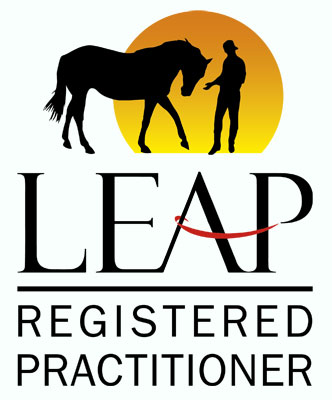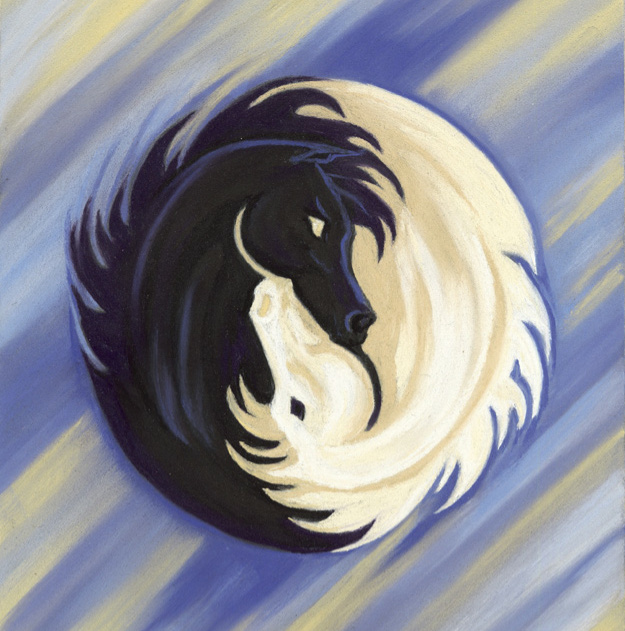
Blog
One wounded soul to the rescue of another…! An account of the effectiveness of the trauma Freeze/Immobility Response in horses
7 February 2022
Themes: Horses, Instincts, Instincutal Respsonse, Trauma, Flight, Fight, Freeze Responses, Immobility, Crisis, Accidents, Recovery, Nervous System, Fear, Panic, Survival, Peter Levine, Waking The Tiger, Trauma Recovery, Healing.
A number of years ago as I was driving to go and feed my own horses, I came upon two loose horses running down the road. Instinctively, I braked and stopped to rapidly assess what was happening. I swung my car around to go back in the direction I had just come, as this was the direction the two horses were racing hell for leather down the main road. As I turned I saw a young girl running out from the lane where the horses had appeared just moments before, I yelled to her to get in and we went chasing after the two horses. It turned out she was one of the grooms at the yard and these two horses were two stallions, no less, who’d accidently got into the same paddock and had instantly begun to fight. We followed them along the main road, I kept praying they would turn off into one of the farm fields on either side, but they just kept going straight on, the one chasing the other, completely locked into the moment and fury of their own combat and utterly oblivious to their sudden and strange new environment.
Thankfully, they then turned left, one careening after the other and bizarrely, down the track to my house that I had just a few minutes before left! (This is not the only strange synchronicity to this event for me, but more on that later). They raced down this small lane which to my relief I knew ended at a farm and small wooded area and fields, so the immediate danger of them being hit by a vehicle was greatly reduced. Again they went left into the farm area and stopped just before a fence and then immediately began to resume their very intense fight, both of them up on the back legs, biting, kicking, screaming, it was sheer pandemonium and hell. The young woman with me, a new and rather inexperienced groom it turned out, was beside herself in fear, panic and guilt as she kept telling me it was her fault; that she had mistakenly left the gate open so that the second stallion could enter the other stallion’s paddock.
The horses kept fighting so ferociously that there was nothing we could do to stop them. We couldn’t get near them and it was just far too dangerous for us to try. Suddenly, the one got the better of the other and the second horse fell down on its side. In another horrible twist of fate, right beneath him and in front of the ram- shackled fencing was an old rusty piece of farming equipment, some kind of a plough, and this horse fell right on top of it. He struggled in vain to get up but was caught in it, his front and hind legs on the side he’d fell onto were both stuck in this open machinery, he struggled and struggled but couldn’t stand. The other horse then turned tail, jumped the fence and scarpered across an open crop field. We simply had to just let him go as we both needed to attend to the trapped horse who was thrashing around in panic.
What followed is a whole story in itself involving the local vets, farmers and fire brigade, plus me and now two grooms from the yard the horses had escaped from, in a race against time to try and save this horse by freeing him. There is for instance, a whole other story about the people involved, especially me and the young groom, mobilising and taking action in order to deal with an emergency situation, rather than letting our fears completely spiral out of control so that we were left helpless and stuck and unable to help the horse when it first happened.
But, what I want to specifically focus on in this piece is how the trapped horse dealt with the situation it now found itself in.
As soon as he realised he was utterly stuck, he stopped struggling completely. He lay perfectly still and went into a kind of trance. He had entered the Freeze or Immobility state which ensures survival, when fight or flight are not an option. I urged the frantic young groom to go and sit at his head and to do whatever she could to keep him calm, which she aptly did throughout, while I set about calling for help and dealing with the second groom who’d now arrived, who incidentally was more experienced and yet in a much more dangerous type of panic; I quickly determined that she could easily escalate the entire situation, potentially agitating the stuck horse so much that he began to struggle again, or much more likely, causing the now calmer first groom to lose it completely as she was being blamed out right and yelled at as stupid by the second groom. So I gave her the best job for all concerned which was to get her away from the immediate crisis scene and to go and wait for emergency services and to bring them down to us.
The help arrived and it took a considerable amount of time and great thought and care to free this horse, including cutting away pieces of the machinery. For not only was he trapped in metal bars, but there was also barbed wire from the fence caught up in both the equipment and the horse. It was hell and very nerve wracking to watch and wait. It seemed to last for hours, yet it probably lasted in total no more than one and a half hours. Because of my own physical state I could do actually very little to help once everyone had arrived. I was myself fairly immobile. So my main task then became to emotionally support the groom as she stayed with the horse throughout. I kept reassuring her about him and about her own precarious situation, as she was sure she’d be instantly fired by her boss; she was terrified on many levels.
Throughout the entire time of the rescue planning and execution, the trapped stallion remained utterly still. It was incredible; he didn’t move or struggle at all, nor make a sound.
Finally, after much very careful cutting and moving of pieces of equipment and barbed wire, he was free and we all stood back as the groom and one of the vets stayed close to him to see if and how we was going to stand up, if at all, and what state he would be in. We all expected serious injury.
Here’s the real miracle of the freeze and immobility state that he had entered: He stood up, gave a couple of vigorous shakes and took a couple of tentative steps and that was it. He was absolutely fine, barely a scratch on him! The groom and I led him to a spare stable on the farm and stayed with him while we waited for his owner to come and collect him with her trailer. I then returned home shocked and exhausted and had to call a friend to go and feed my horses as I was done-in.
The other bit to this whole ordeal is that I was in the very early days of recovery from my own nasty riding accident just one week earlier! I could only just walk and was weak and vulnerable and VERY wary of getting hurt again. That I went through this second traumatic event so soon after and involving horses is such bizarre timing, I suspect there was a strange kind of synchronicity going on. The timings of me leaving the house that day and driving past JUST at the exact moment the two horse fled down my road and then down my track past my house, well, you simply couldn’t make it up.
Having read much about trauma states and responses and having lived a life myself habitually entering the freeze response, I find it fascinating now to look back on this incident and reflect on the sheer ingenuity of this natural survival instinct and response. Yet one which gets less attention than the other two much better known ones of flight or fight.
But, on this occasion, that horse had absolutely no way of: a) fleeing, or b) fighting his way out of that broken farm equipment. His entire being utterly surrendered to his condition in order to help him survive. His heart rate slowed right down, his huge powerful body became completely motionless and his mind seemed to enter a trance-like zone. All of which enabled everyone trying to carefully free him to do just that; no small task as the biggest danger was causing further more severe injury to either the horse or themselves in the process. But, he absolutely instinctively knew to keep still until it was over and the danger had passed.
Also remarkable, was the rapid way he recovered! A few shakes, a couple of steps to get moving and that was it! It was remarkable to witness. It took me a couple of hours to normalize my nervous system afterwards involving strong hot tea and getting warmed up, the adrenaline was coursing through me for a couple of hours. Yet, this gorgeous horse, who it also turned out was the owner’s PRIZE stallion on her breeding yard, walked away without a scratch and absolutely fine. Incidentally, the other stallion who fled was also found unharmed thankfully and taken back home.
I remember hobbling along to my weekly therapy appointment the next day and relaying the incredible experience to my therapist who sat, mouth open, listening, especially as we were so focused on helping me recover from my own traumatic riding accident which had left me in a bad way physically and emotionally.
In his now seminal and classic book on trauma, ‘Waking The Tiger: Healing Trauma’, Peter Levine says this about the Freeze/Immobility response:
“On the biological level, success means surviving not winning and it doesn’t matter how you get there; the object is to stay alive. Nature places no value judgement about which is the superior strategy. Animals don’t view freezing as a sign of inadequacy or weakness; nor should we. This response requires no conscious choice, nature instinctively chooses the best response in the moment. These choices aren’t thought through, they're instinctively orchestrated by the reptilian and limbic brains. When flight or fight won’t ensure survival, a third response – Freeze/Immobility kicks in. It’s an equally viable strategy as flight or fight and in many situations, it is the best choice”.
And, as he talks about when he describes the experience of the Impala who is brought to the ground by a cheater, he describes it as “surrendering to its impending death”. “The stone-still animal is not pretending to be dead. It has instinctively entered an altered state of consciousness shared by all mammals when death appears imminent.
Physiologists call this altered state the “immobility” or “freezing” response. It is one of the three primary response is available to reptiles and mammals when faced with an overwhelming threat.
Nature has developed the immobility response for two good reasons. One, it serves as a last-ditch survival strategy. Secondly, in freezing, the [animal or human] enters an altered state in which no pain is experienced.”
Levine also of course describes in detail what happens when the animal, or person, comes out of this freeze/immobility response and how animals are much more adept at releasing the stuck and frozen energy instantly, preventing it from staying blocked in the nervous system and the traumatic pattern repeating: “the spontaneous shaking and trembling that we see throughout the animal world”, which he describes when the Impala realises she can make a break for it and she races from danger.
This ability to unfreeze and discharge the pent-up energy from the nervous system is what animals can so beautifully teach us so that we don’t remain stuck in frozen, immobile states of helplessness and powerlessness with a nervous system on high alert all of the time. Instead, we can get to our feet, shake and move about as it is in this moving and the shaking it seems that we can return to a state of homeostasis, just as the stallion managed so instinctively to do that day, a day I will never forget…
Angela Dunning, 7th February 2022, The Horse's Truth








